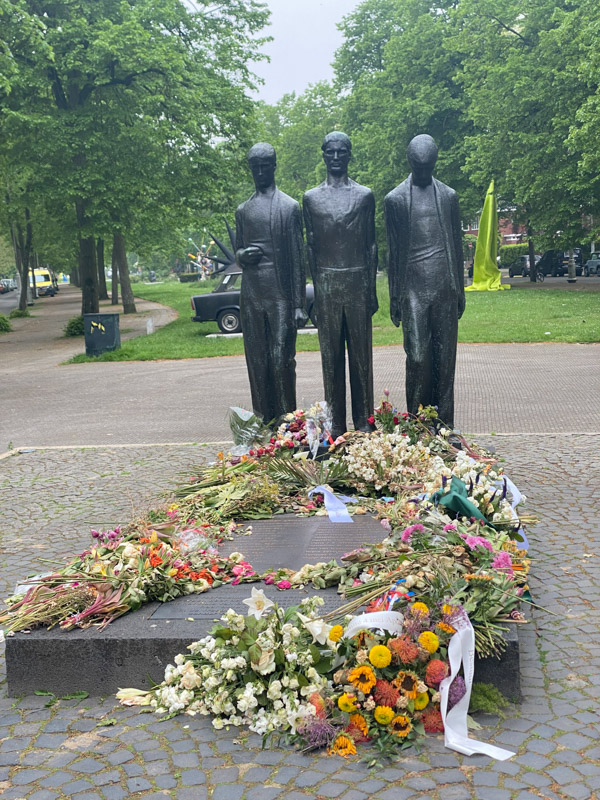Meditations on death, grief and healing in Kenya and the Netherlands.
I know—I belong to a generation obsessed with graves. Their permanence has become our language of love, our way of asserting legacy and resisting the ephemeral nature of life.
After a long absence, the first ritual of returning home—before embracing eager relatives or sitting down to lunch—is to ask: "Where are their graves?" It is customary to stand by the graves of those whose funerals you couldn't attend, to finally offer your last respects. These gestures are not mere courtesies; they arise from a deep-seated impulse, a fundamental part of one's being.
My older brother is a devoted martial artist and a lifelong Bruce Lee fan. During a visit to the U.S., he made a special trip to Lake View Cemetery in Seattle and took a photo beside the grave of his icon. I also have a friend, a passionate Rumba enthusiast, who cherishes a photo taken at Nsele Necropolis in Kinshasa, where legends of Congolese Rumba—Tabu Ley Rochereau, Papa Wemba, Tshala Muana, Lutumba Simaro, and General Defao—are laid to rest.
In 1990, just five months into his freedom after 27 years of imprisonment, Nelson Mandela landed on Kenyan soil. His first and unwavering request was not for a state banquet, but for something far more elusive: the grave of his icon, Field Marshal Dedan Kimathi of the Kenya Land and Freedom Army. At the time, still in high school, I saw only the irony—a prominent street and, later, a statue in Nairobi—without grasping the deeper shame it revealed: a nation that honoured its hero in stone, yet concealed his resting place like a dirty secret. Kimathi’s remains are believed to lie somewhere within the grounds of Kamiti Maximum Prison, their exact location still unknown. How many revolutionaries might have followed Mandela’s example, journeying from across the world to stand at that grave?
My inherent reverence for the dead accompanied me to the Netherlands, where I instinctively extended that solemn respect to its cemeteries. My preconceived notions of European burial grounds—shaped by gothic tales of eerie moonlight and crumbling stone—were quickly dispelled when I encountered serene, green oases seamlessly integrated into the urban landscape. This realisation came quite by accident.
I had made a few visits to the African-dominated English service church in Amsterdam, nestled next to a quaint park, before I realised it was adjacent to a cemetery hiding in plain sight. One Sunday, needing space for my fussy daughter to roam, I stepped outside—and there they were: rows of well-maintained graves, openly accessible. I was struck by how one could walk through uninterrupted, almost like browsing a mall, gazing at the 'displays' of lives lived. My curiosity eventually led me to wander the grounds like a tourist—not merely observing but mesmerised by their orderly arrangement and the profound dedication to preservation. It was an orderliness that whispered of generations, a silent agreement to remember.
I have since walked through many cemeteries, gazing at tombstones and trying to piece together their stories from the epitaphs. The manicured lawns, the uniform headstones, the weathered dates. I have walked softly along gravel paths, as if not to disturb the dead—passing rows of granite lined up like soldiers awaiting inspection, each bearing just a few lines to tell a silent story.
They carried no discernible scent—no must of age or earth. If I had to describe it, I’d call it the smell of sterile serenity. I once met with an acquaintance, an Italian journalist, in Amsterdam’s South neighbourhood. She suggested we take advantage of the good weather and proposed a pleasant spot outdoors. We met in a forested park, and only after the meeting did I realise we had been relaxing among the dead. For a moment, I thought how impossible it would be to convince my relatives back home that I hadn’t unwittingly stumbled into some clandestine, ritualistic gathering.
In my own neighbourhood, I’ve seen three cemeteries within a 3 km radius. Some of the graves have been there a long time. I remember one: Johannes, born in 1904, died in 1971. Entire lives lived and departed before mine had even begun. The headstones I encountered in churchyards dated even further back—1880! Those would have been my great-grandfather’s age mates. I had no idea where my grandfather’s father was buried. It had never even occurred to me to ask.
As any seasoned traveller knows, sometimes you have to leave home to truly see it. From this distance—amid Holland’s solemn, orderly graveyards—I gained a stark new clarity about my own people’s evolving customs. My village in Siaya is indeed dotted with private cemeteries, often grotesque cement slabs and prominent crosses declaring their presence at the very entrances of homes. The more prominent the family name, the larger and more imposing the mausoleums, which dominate the homestead’s atmosphere, casting a lingering sense of tragedy—especially where graves appear better maintained than the homes they serve.
I grew up amid the renowned legal battle over the remains of lawyer S.M. Otieno, contested between his wife, Wambui Otieno, and his ancestral Umira Kager Clan. The cultural imperative was to return the body to the ancestral homeland, regardless of where he had chosen to live or settle elsewhere in the country. This was a customary duty, rooted in the belief that the departed would not find peace unless reunited with their spiritual landscape. Yet I witnessed this profound spiritual truth and deep reverence among my people become reduced to a mere status symbol, evolving into a commercial industry that has transformed the cost of dying into an exorbitant burden.
Monuments of the past have become more important than the people themselves.
These monuments to the past, tragically, have become more important than the people themselves. We are now stuck with what Ngugi wa Thiong'o captured in the anecdote of the Mercedes funeral: the opulence of the funeral service, in stark, jarring contrast to the poverty and struggles of the common people. The spectacles, I’ve observed, have become like meticulously curated weddings for Instagram pages—solemnity overshadowed by pomp, spiritual function either lost or reduced to a pitiful mimicry: a sacred dirge, like Oliver Mtukudzi’s ‘Todii,’ misheard as a party anthem, its profound meaning lost in translation.
It wasn’t always like this. In my own village, finding a grave dated before 1970—before the pervasive culture of cemented graves—is difficult. Before then, graves were marked by the land itself: the planting of a tree, the placement of rocks. I have a brother who died in infancy long before I was born; his grave is unmarked, known only because a gigantic Mama Mutere tree grew from that spot, its enduring roots a silent testament to the life lived.
We no longer do that. Though we may ‘spew dust to dust’ with our lips, we seal the spot in cement—striving for a permanence that defies the very nature of decay. Even if the home crumbles around it, these graves remain rigid markers of former occupants, akin to the stark visages of Black faces from the Golden Age that adorn Amsterdam’s canal district buildings—silent reminders of lives long past.
What does it mean for a burial site to be part of the living landscape? My grandmother explicitly requested that her grave not be cemented. The spot where she was laid to rest is now overgrown and were it not for the cement family graves surrounding it, one would never be the wiser.
I know, I am part of a grave-obsessed generation. The permanence of graves is our language of love, our attempt to control legacy and to push back against the ephemeral nature of life.
It is such an ingrained custom that I recall a friend who was on a research trip in Pokot country, northwestern Kenya. As he moved from homestead to homestead, it struck him that he had not seen any tombstones or crosses. When he asked, “Where are your graves?” he was told of the custom of burying prominent men within cattle kraals, while others are laid to rest in simple graves.
How do I teach my children—growing up away from home—to remember the dead when they have no physical markers to visit?
I can name my grandfather’s siblings, even though I was born after they had all passed and can recall only one grave. Yet, I carry their stories and their names. This is how we remember—through oral, collective memory. It is a naming tradition I inherited and now pass down. My children bear the names of our dearly departed, and one day, they too will begin their own inquiries, ask about their names, and remember. Beyond the meticulous paperwork of wills and the bureaucracy of burial permits, my approach to end-of-life planning must evolve.
What does it mean to live with ancestors?
So, the task of remembering correctly is on us—that we can revisit what ancestral veneration really meant and why libations were so important. What does it mean to live with ancestors? To accept that physical absence doesn’t connote separation but simply a change of form, where they move to the spiritual realms, remaining ever-present actors in the lives of the living.
We now think of the unmarked grave as forgotten; yet this is essentially our destiny, for we too will eventually be forgotten in the long arc of history—an inevitable consequence of the ephemeral nature of individual life.
There is no right way to remember, and within the spectrum of humanity, influence is contagious. In the Netherlands, I stare at our nation’s future. Kenya’s largest burial site, Lang’ata Cemetery in Nairobi, was declared full nearly two decades ago in 2008, yet every month news arrives of burials taking place there. Despite its dire state, Lang’ata remains the preferred choice for many Nairobi residents due to its convenient location and accessibility compared to the city’s eight other public cemeteries. How long before we, like the Dutch, prioritise the efficiency of disposal and change our ways? The Netherlands now boasts cremation rates that have reached over 60%.
For me, I turned to writing—to storytelling—so that my family might read about those who came before us, inspiring others to discover and share their own stories. This, in turn, sets off a chain reaction: the sacredness of the story, passed down from one generation to the next. Ultimately, we can only build our own archives of sorrow, curated by ourselves and for ourselves.
These silent rows of the Dutch cemetery speak to a universal yearning—for connection beyond life, for meaning across the veil of time—and we possess a profound technology to bridge this. This is why we no longer say rest in peace; instead, we say journey on, to the land of the ancestors. For us too, one day, we will join the collective. In this simple understanding, the limitations of separation are revealed: death is not an end, but a transition.
I began to understand what philosopher John S. Mbiti called the “living dead” – those whom we knew, whose stories we still carry, who remain with us in a palpable present even after their physical departure. Beyond them lies the deeper “past,” the collective immortality of ancestors who become part of the very soil and spiritual heritage of the community.
I finally came to understand my late grandmother, Wahonya. In her late sixties, she would affectionately call a teenager like me "my husband," reminding me that the spirit I embodied transcended the individual and connected me to a powerful spiritual lineage.
It forces me to see the earth differently—a return to the source of life that renders our obsession with graves almost meaningless. We say "dust to dust," but do we truly grasp that the earth quite literally reabsorbs us? Unlike a plastic bottle that outlasts our bones, we—our bodies—become part of the cycle, offering a radical reinterpretation of environmental awareness. In the long arc of time, no matter how important we think we are, we become manure—plant food. Like a leaf falling from a tree, we decompose, returning nutrients to the soil, becoming the very ground from which new life emerges. Our interconnection extends beyond humanity, encompassing all forms of life. Perhaps the Buddhists, in their enduring wisdom, truly received the right memo when they spoke of all beings.
My late uncle Kamil Oluoch Kamili used to say, “Piny osiko, to ok sike”—the earth is eternal, but our lives are not.
As the global African community settles in far-flung places, they must carry their living dead with them, so that when the time comes, geographical distance will not hinder those who cannot visit their graves. We will never say they were lost to the West; rather, they remain with us—accessible through the veneration of our rituals and the power of our imagination.
P.S. This reflection on remembrance is drawn from my meditations on death, grief, and healing. It is part of a series of insights from my upcoming book, Strength and Sorrow, where I explore these universal experiences and the paths to healing amidst loss.
This story was previously published on Substack.
Subscribe to Oyunga’s page.


